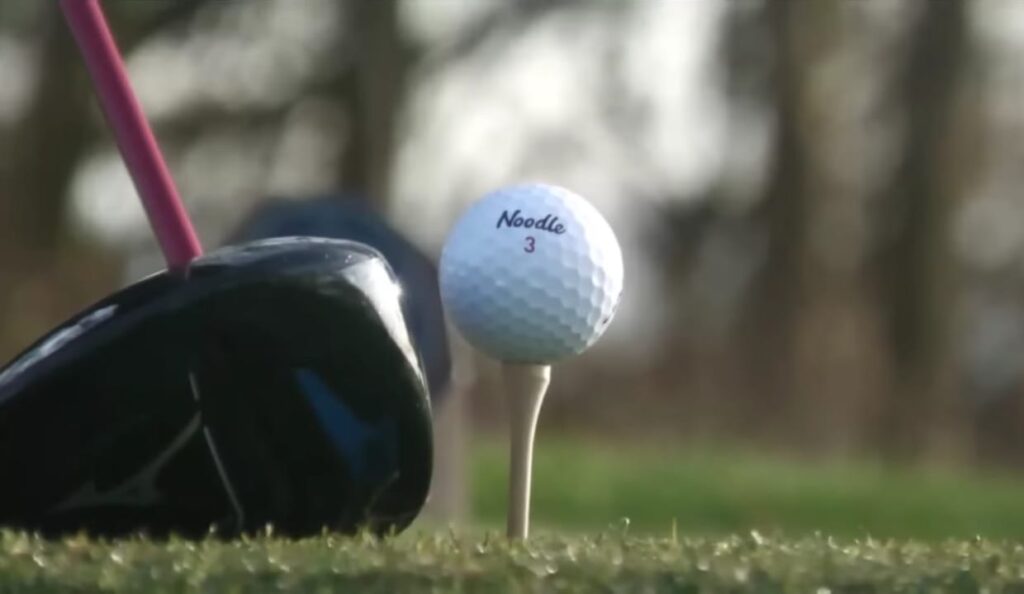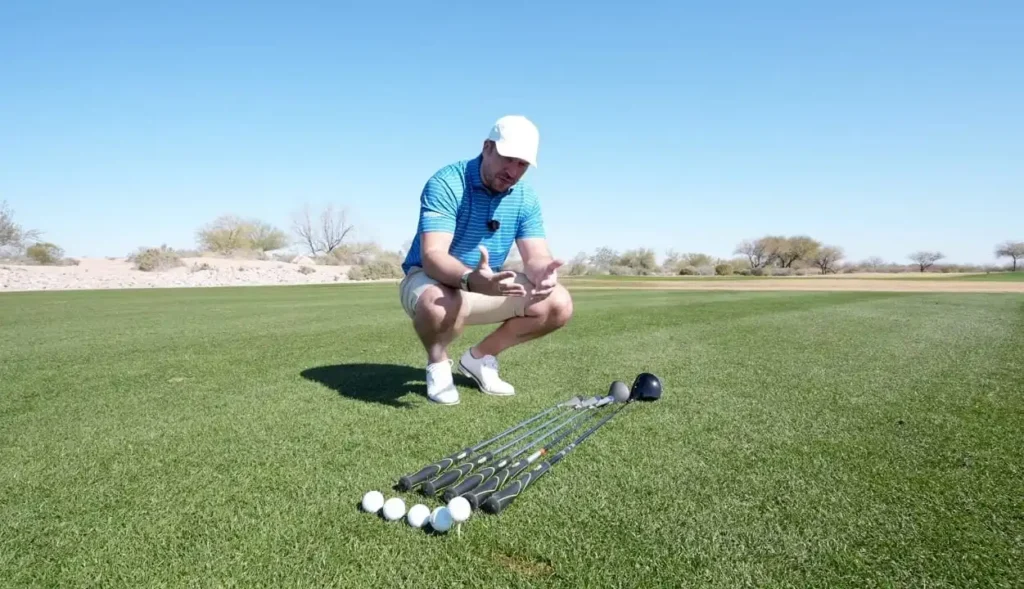Golf, with its serene landscapes and strategic challenges, offers enthusiasts a unique blend of precision and skill. However, every golfer encounters situations that test their adaptability on the course. One such scenario that often perplexes players is dealing with a ball lying below their feet. As the fairway slopes away, the dynamics of the shot change, demanding a nuanced approach. So, what to do in the “ball below feet golf” scenario?
In this guide, we will delve into the intricacies of handling shots when the ball is below your feet, offering insights and tips to help you navigate this challenging terrain and improve your overall game. If you want to tackle the “golf ball below feet” scene then read this article carefully. Don’t mind the weird wording of “ball below feet golf” because that’s the keyword we’re using to give this article more reach. Without further ado, let’s understand the challenge.

Understanding the Challenge
Downhill lies in changing the dynamics of your swing, necessitating adjustments to both setup and technique to address common obstacles, such as risking topping the ball, distance control concerns, and potential slices. That’s the problem you face when dealing with the “ball below feet golf” challenge. So, let’s examine some key aspects of mastering shots from downhill lies. Read the below-mentioned setup carefully so you can tackle this challenge efficiently.
Optimal Setup for Success
1. Bend Your Knees for Balance
Downhill lies may cause the ball position to lower naturally, increasing your risk of topping it. If you wish to excel at the “ball below feet golf” scenario and minimize this effect then lower your overall stance. Try to bend from knees and hips while making sure that your chest is facing forward while maintaining an appropriate balanced posture. That’s how you can succeed at landing a ball below your feet golf-style.
2. Grip at the Top of the Club
Grip the club at its uppermost grip to maximize its length and ensure maximum control and ball impact. Doing this allows for optimal distance-reaching performance, helping you tackle the old “ball below feet golf” challenge professionally.
3. Aim Left of the Target
Account for the natural rightward trend on sloped terrain by shifting slightly left when setting your target position. Now, this helps compensate for a steeper swing angle and ensure optimal results. Aiming left on the target is, as you can guess, a very simple suggestion for all those right-hand golfers out there.
4. Use a Longer Club
Select a club with more loft than is customary for the distance you plan to play. It allows a smoother, controlled swing that helps maintain balance and ensure optimal play. That’s how you can tackle the “ball below feet golf” challenge very efficiently.,
Technique for Stability
So, what kind of technique do you need to overcome the “golf ball below feet” problem? This part will share with you some tips and tactics for stability. If you wish to remain stable then do not forget to use these simple recommendations:
1. Adjust Your Weight Distribution
On downhill lies, properly shifting your weight is paramount to successful play. Be mindful to distribute it towards your toes to avoid falling backward during the swing. So, this adjustment ensures stability and allows for cleaner strikes, helping you control that ball below your feet golf-style.
2. Widen Your Stance
Increase the width of your stance to enhance stability and decrease swing arc, therefore, getting closer to the ball and encouraging clean contact with it. All you need to do is to have a wider and more open stance to overcome the old “ball below feet golf” problem.
3. Bend Your Knees Further
Due to the lower position of the ball, make sure your knees bend more than usual during each swing if possible. Now this will prevent thin shots or misshits. Maintain this knee flex to achieve great shots and you can easily tackle the “ball below feet golf” challenge.
4. Use One More Club and Swing Smoothly
Counterbalance the challenge posed by sloped terrain by using longer clubs with smoother swings to compensate. This strategy helps restore balance when playing on steeper hillsides. You can easily defeat the “golf ball below feet” problem with this simple strategy.
5. Use a Less Lofted Club
Downhill lies often result in lower trajectory shots. If you wish to counter this effect, consider opting for a club with less loft than would usually be recommended; this should promote more accurate shots that require precise control and precise execution. In short, using a less lofted club is the key to landing that ball below your feet golf-style.

Technique for Success
So, let’s share some more tips for success here. You cannot overcome the “ball below feet golf” challenge without the following tips. We have made sure these tips help you always land that ball below your feet golf-style. So, grab on hold (of your club), and let’s delve deep into this amazing section:
1. Adapt Your Swing Plane
Downhill lies require you to adapt your swing plane accordingly. Instead of adopting the traditional golf swing plane, adopt an altered swing that promotes greater contact between the ball and clubface and reduces thin shots by taking an alternative path through your swing path. This modification helps prevent thin shots while improving contact. That’s how you’ll beat the “ball below feet golf” conundrum.
2. Embrace the Slope
Work with rather than against your slope. Allow your body to adapt naturally to a downward incline by moving your lead shoulder lower during each backswing, keeping in step with its contours. And that’s the best way to deal with the “golf ball below feet” situation.
3. Aim Slightly Right
Due to a downhill slope, shots tend to veer left for right-handed golfers. To combat this tendency, aim slightly right of your target. So, this helps bring it back onto the target more effectively. You can easily beat the “ball below feet golf” curse simply by aiming slightly at an angle.
Expert Advice
We have also gathered some unique intel for you. So, GOLF Top 100 Teacher offers invaluable insights for those facing a ball-below-feet problem. In short, you gotta adapt and adjust. Let’s explain the solution in-depth for your perusal. Here’s what you gotta do if you ever find yourself in a “ball below feet golf” situation.
1. Adapt Your Setup
Rose suggests getting lower into your stance to ensure an increased chance of hitting the ball squarely and not topping it. This approach should increase the chances of hitting it well enough.
2. Adjust Your Aim
Acknowledging the rightward tendency of sloped surfaces requires adapting accordingly by shifting leftward – in line with gravity’s pull. That’s how you land that wayward golf ball perfectly.
Conclusion
In the ever-evolving journey of a golfer, mastering diverse terrains and situations is the key to consistent improvement. Addressing the unique challenges posed by a ball below your feet requires a combination of technique, focus, and understanding of the game’s nuances. By incorporating the insights shared in this guide into your practice and play, you’ll be better equipped to approach sloping fairways with confidence.
Remember, every shot is an opportunity to refine your skills and embrace the beauty of the game. So, the next time you find yourself on uneven ground, not able to solve the “ball below feet golf” problem, face the challenge head-on. You gotta adjust your stance and swing with the knowledge that you have the tools to conquer the course, one slope at a time. Happy golfing!

FAQs – Mastering Various Golf Lies
1. Where should I aim when the golf ball is below my feet?
When faced with a ball below your feet, aim slightly left of your target to counterbalance anticipated rightward movement due to your steeper swing plane. This should give the best shot in a “ball below feet golf” situation.
2. How do I approach hitting shots on downhill lies?
In downhill lies, maintain balance by adjusting your stance by slightly tilting forward of center and positioning your weight slightly below center. Do all this while trying to strike cleanly using swinging along a natural gradient.
3. What’s the strategy for playing a hanging lie on the golf course?
When faced with a hanging lie, bend your knees more to accommodate for its lower position and grip the club at its top to minimize slope effects. Widen your stance slightly as well. Aim slightly left when playing off of a sloped surface.
4. How can I effectively hit a golf ball when it’s below my feet?
To successfully navigate a ball below your feet, utilize a steeper swing, widen your stance, and aim left. Maintain equilibrium by shifting weight back onto your heels, while playing slightly forward within your stance. That’s how you can overcome the “ball below feet golf” situation.
5. Does the golf ball consistently go in a particular direction when below the feet?
Yes, when hitting from below, your feet the ball typically will tend to curve right (for right-handed golfers). Being aware of this phenomenon allows golfers to make adjustments necessary to produce accurate shots.
6. Why does the golf ball tend to go right when it’s below my feet?
Due to a steeper swing plane caused by sloped terrain, right-handed golfers often experience right-to-left spin on their ball which causes it to curve rightwards when hitting from right-hand stance. That’s why you gotta aim at an angle when playing from a ball-below-feet perspective.
7. How should I adjust my aim when the ball is below my feet?
If you intend to offset an expected rightward drift, aim slightly left of your intended landing spot to compensate and adjust your shot so it will land where intended. This helps align it more precisely, letting you solve the “ball below feet golf” conundrum.
8. Does the slope impact the distance the ball travels?
Yes, a slope can have an impactful influence on distance. Golfers might experience some decreased power because of a steeper swing plane. If you’re aiming to combat any potential power losses, it would be wise to select a club with slightly increased loft as insurance against potential power losses.
9. Should I change my stance when playing a ball below my feet?
Yes, adapting your stance is vitally important. Strive for a balanced setup by shifting weight onto one foot at a time while widening out your stance for additional stability on sloping terrain. So, it’s a great way to overcome the “ball below feet golf” challenge.
10. Can I use the same club as I would on a flat lie?
In general, it’s wiser to select a slightly longer club for use when lying steeper swing planes due to potential power losses associated with steeper swing planes. This helps compensate for potential power reduction due to steeper swing planes.
11. Does the ball below the feet scenario impact left-handed golfers differently?
Yes, left-handed golfers tend to display different tendencies than right-handers when hitting with their left side, such as producing left-to-right spin on their ball. In short, these adjustments will need to be considered when setting aim or swing plane so you can conquer the “golf ball below feet” situation.
12. How can I ensure balance when playing from a ball-below-feet lie?
To adapt to the lower positioning of the ball, bend your knees more than usual to ensure stability during setup and shift most of your weight toward heels. That’s how you can ensure proper balance when trying to play in a “ball below feet golf” situation.
13. Is it advisable to take a full swing when the ball is below my feet?
While full swings may be feasible, for balance and accuracy it may be more advantageous to prioritize control over power. Consider going for an unhurried swing for maximum accuracy and balance. That’s how you can land a ball below your feet golf-style.
14. Are the adjustments different for different degrees of slope?
Slope inclination plays an essential part. On steeper hillsides, take more drastic measures regarding aim and stance changes. The trick is to practice shooting on various gradients to gauge their effect on your shots.
15. Can I employ the same strategies for a hanging lie in a bunker?
Although certain general principles apply, playing from bunkers presents unique obstacles and requires specific guidance to achieve optimal performance in such scenarios. Seek advice regarding bunker play for optimal results. And now we’re putting an end to our “ball below feet golf” discussion.











